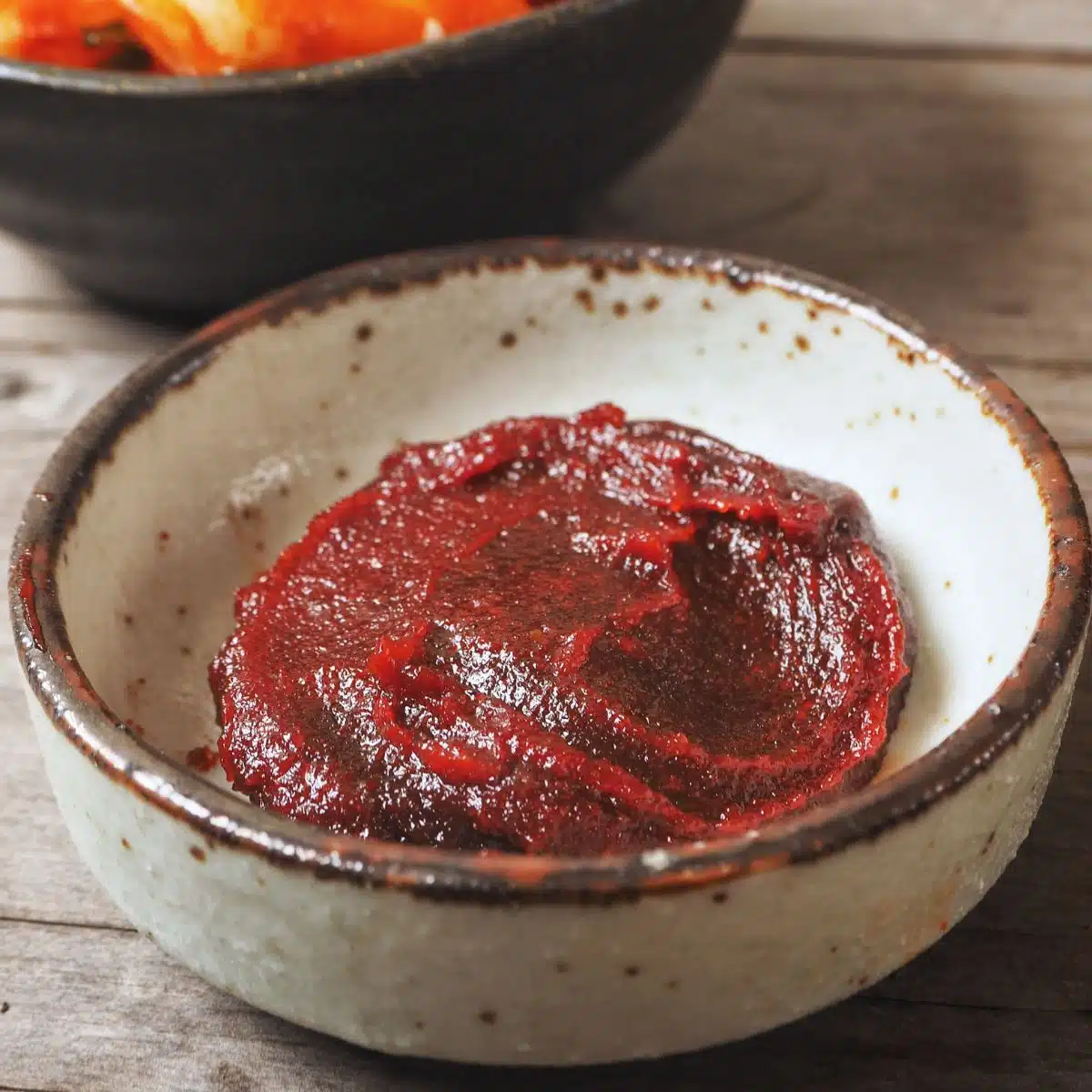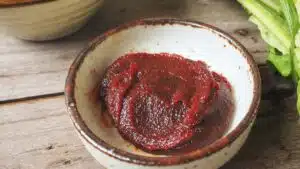A gochujang substitute is a great thing to have on hand if you ever find yourself without gochujang while cooking Korean cuisine! From sriracha to red pepper flakes and more, there are plenty of ingredients that can be swapped for gochujang in any recipe. If you're missing the flavor of this Korean red chili paste, don't worry, I've got you covered!
Best Gochujang Substitutes & Alternatives
Gochujang is an essential ingredient in Korean cuisine. It's a spicy, savory, and sweet red chili paste that adds flavor and spice to many dishes. Unfortunately, not everyone has access to it. That's why it's important to know the best gochujang substitutes that can be used in place of the traditional ingredient.
In this article, we'll discuss some of the best alternatives for gochujang, including my easy homemade gochujang sauce recipe, as well as other ingredients that can add similar flavor and spice to your favorite dishes!

Jump to:
- Best Gochujang Substitutes & Alternatives
- What Is Gochujang
- What To Use In Place Of Gochujang
- 1. Homemade Gochujang Sauce
- 2. Red Pepper Flakes
- 3. Chili Paste
- 4. Sriracha Sauce
- 5. Harissa
- 6. Sambal Oelek
- Table 1: Quick Gochujang Substitute Reference
- 7. Ssamjang
- 8. Doenjang
- Picking The Best Gochujang Substitute
- 📖 Recipe Card
- 💬 Comments & Reviews
What Is Gochujang
Gochujang is a popular Korean condiment that has become increasingly popular worldwide due to its unique flavor and versatility. It is a thick, spicy, and slightly sweet paste made from red chili peppers, glutinous rice, fermented soybeans, and salt. The paste is left to ferment for several months, resulting in a deep, complex flavor profile that is spicy, slightly sweet, and slightly tangy.
Gochujang is a staple ingredient in many Korean dishes, including soups, stews, marinades, dipping sauces, and much more. It is used as a base for various Korean condiments and sauces, such as ssamjang, a dipping sauce for grilled meats, and bibimbap sauce, a spicy sauce used in the popular Korean rice bowl dish.
While gochujang is widely available in Korea and some Asian markets, it can be challenging to find in certain regions outside of Asia. This can be frustrating for those who want to try out Korean recipes that require gochujang, but it is not available at their local grocery store. Moreover, it may be challenging to find authentic gochujang outside of Korea, as some brands that are marketed as gochujang may not use traditional ingredients or fermentation methods.
What To Use In Place Of Gochujang
These substitutes are readily available at most grocery stores and can provide a similar taste and texture to gochujang, making them an excellent alternative for those who are unable to find the real thing. By using these substitutes, you can still enjoy the flavors of Korean cuisine without having to worry about finding authentic gochujang.
1. Homemade Gochujang Sauce
With the right ingredients, making gochujang from scratch isn't all that difficult! Here's what you'll need:
- Gochujang Paste - 3 tablespoons of gochujang paste. This is sold at most Korean grocery stores, sometimes you can find it at Kroger, Albertsons, or Fred Meyers, and it is also available for purchase on Amazon.
- Rice Vinegar - 2 tablespoons of rice vinegar.
- Soy Sauce - 2 tablespoons of soy sauce.
- Lemon Juice - 1 tablespoon of lemon juice, I recommend using freshly squeezed juice for the best flavor.
- Agave Nectar - 1 teaspoon of agave nectar for sweetness.
- Ginger Paste - 1 teaspoon of ginger paste, or you can use 1 frozen ginger cube, or ½ teaspoon of freshly grated ginger.
- Salt - ½ teaspoon of salt.
- Sesame Oil - 1 tablespoon of sesame oil gives it a rich smokey flavor.
- Avocado Oil - 1 tablespoon of avocado oil.
- Garlic - 2 cloves of garlic, minced.
- Water - To thin out the sauce as needed.
How To Make Gochujang Sauce
First, measure out all of your ingredients. Then, grab a mixing bowl, spatula, and a small saucepan to get started.
- Mix. Add 3 tablespoons of gochujang paste, 2 tablespoons of rice vinegar, 2 tablespoons of soy sauce, 1 tablespoon of lemon juice, 1 teaspoon of agave nectar, 1 teaspoon of ginger paste, and ½ teaspoon of salt to a mixing bowl and stir to combine.
- Cook. Place a small saucepan on the stovetop over medium heat and add 1 tablespoon of sesame oil, 1 tablespoon of avocado oil, and 2 minced cloves of garlic to the pan. Cook until the garlic is fragrant and slightly brown.
- Simmer. Pour the gochujang mixture from the mixing bowl into the pan and stir to comine. Let simmer over medium heat for 3-5 minutes, adding water as needed to thin out your sauce to your desired consistency.
- Enjoy. Use your homemade gochujang in any of your favorite recipes or store for later!
To store your DIY gochujang sauce, place it in an airtight continer and refrigerate for up to 1 month.
2. Red Pepper Flakes
Red pepper flakes are a common spice used in many cuisines, including Korean. They are an excellent substitute for gochujang because they provide a similar level of spiciness.
Red pepper flakes are made by drying and crushing red chili peppers, resulting in a flaky texture. They have a slightly sweet and smoky flavor and can add a nice depth of flavor to dishes.
To use red pepper flakes as a substitute for gochujang, mix them with a few other ingredients such as sugar, rice vinegar, and soy sauce, to create a sauce. This sauce can be used as a marinade or dipping sauce for grilled meats, or as a base for soups and stews.
Red Pepper Flake DIY Blends
- Red Pepper Flakes and Miso: Mix 1 tablespoon of miso paste with 1 tablespoon of red pepper flakes. This will give you a similar flavor profile to gochujang, but with less sweetness and a slightly different texture.
- Soy Sauce, Honey, and Red Pepper Flakes: Mix 1 tablespoon of soy sauce, 1 tablespoon of honey, and 1 tablespoon of red pepper flakes. This blend will provide a similar level of sweetness and spiciness as gochujang, but with a thinner consistency.
- Tomato Paste, Honey, and Red Pepper Flakes: Mix 1 tablespoon of tomato paste, 1 tablespoon of honey, and 1 tablespoon of red pepper flakes. This blend will provide a similar level of sweetness and thickness as gochujang, but with a slightly different flavor profile.
3. Chili Paste
Chili paste is another great substitute for gochujang. It is made by grinding red chili peppers with garlic, vinegar, and salt. It has a spicy, tangy, and slightly sweet flavor that is similar to gochujang.
Chili paste has a thicker and smoother texture than red pepper flakes, which makes it ideal for use in marinades and sauces.
To use chili paste as a substitute for gochujang, simply replace the gochujang with an equal amount of chili paste in your recipe. Keep in mind that chili paste can be quite spicy, so adjust the amount you use accordingly.
4. Sriracha Sauce
Sriracha sauce is a popular hot sauce that is made from chili peppers, vinegar, sugar, and garlic. It has a sweet and spicy flavor that is similar to gochujang. Sriracha sauce has a thinner consistency than gochujang, but it still works well as a substitute in many dishes.
To use Sriracha sauce as a substitute for gochujang, mix it with other ingredients like sugar, soy sauce, and rice vinegar to create a similar flavor profile. This sauce can be used as a marinade, dipping sauce, or base for soups and stews.
>>>>See all of my recipes here<<<<
5. Harissa
Harissa is a North African chili paste that is made from roasted red peppers, garlic, and a variety of spices, including cumin and coriander. It has a smoky, spicy, and slightly sweet flavor that is similar to gochujang. Harissa has a thick and grainy texture that makes it ideal for use in stews and soups.
To use harissa as a substitute for gochujang, mix it with a few other ingredients like soy sauce and rice vinegar to create a similar flavor profile. This sauce can be used as a base for soups and stews, or as a marinade for meats.
6. Sambal Oelek
Sambal Oelek is a spicy chili paste made from fresh chili peppers, vinegar, and salt. It has a similar texture to gochujang but has a more concentrated heat. Sambal Oelek has a fresh and bright flavor that makes it ideal for use in Southeast Asian cuisine.
To use Sambal Oelek as a substitute for gochujang, mix it with other ingredients like sugar, soy sauce, and rice vinegar to create a similar flavor profile. This sauce can be used as a marinade, dipping sauce, or base for soups and stews.
>>>>See all of my recipes here<<<<
Table 1: Quick Gochujang Substitute Reference
| Substitute | Flavor Profile | Texture | Best Used In |
|---|---|---|---|
| Red pepper flakes | Spicy, slightly sweet, smoky | Flaky | Soups, stews, marinades, dipping sauces |
| Chili paste | Spicy, tangy, slightly sweet | Thick and smooth | Marinades, dipping sauces, soups, stews |
| Sriracha sauce | Sweet, spicy | Thin and runny | Marinades, dipping sauces, soups, stews |
| Harissa | Smoky, spicy, slightly sweet | Thick and grainy | Stews, soups, marinades |
| Sambal Oelek | Spicy, fresh, bright | Thick and chunky | Dipping sauces, marinades, soups, stews |
Note that the texture and flavor of these substitutes can vary depending on the brand and specific ingredients used. However, this table provides a general overview of some of the most common substitutes for gochujang and their recommended uses in different dishes.
7. Ssamjang
While ssamjang and gochujang are both Korean condiments made from fermented soybean paste, they have different flavor profiles and are not direct substitutes for one another.
Ssamjang is typically made with a mixture of doenjang (fermented soybean paste), gochujang, garlic, and other seasonings. Since one of the ingredients is gochujang itself, you can see why with a little alteration this could make a very viable substitute!
Ssamjang has a savory, slightly sweet flavor and a thick, spreadable consistency, making it a popular condiment for Korean lettuce wraps (ssam) or as a dipping sauce for vegetables and meat.
Gochujang, on the other hand, is made primarily from fermented chili peppers and is spicier and more pungent than ssamjang. It is often used as a seasoning or marinade for meat, as a base for stews and soups, or as a spicy condiment for rice and noodles.
While ssamjang may not be the best direct substitute for gochujang, it can still be used as a flavorful and versatile condiment in many Korean dishes. It is, however, one of the best and easiest store-bought products to use.
Ssamjang + Red Pepper Flakes
Leave it as-is if you're not a fan of spicy condiments. If you like it hot, spice up the ssamjang with some red pepper flakes to make the flavor profile as close as possible to gochujang.
Ssamjang + Maple Syrup + Chili Powder
Another great combo to best mimic the flavor of gochujang is to combine ssamjang with a splash of pure maple syrup. Adjust to taste, then add chili powder or cayenne powder to taste as well.
8. Doenjang
Doenjang is a Korean fermented soybean paste that is often used as a seasoning or condiment in Korean cuisine. While it has a similar base ingredient to gochujang, it has a distinct flavor profile and is not a direct substitute for gochujang.
Doenjang has a savory, salty flavor and a slightly grainy texture, and is often used to add depth and complexity to stews, soups, and other savory dishes. It can also be used as a dipping sauce or a spread for bread and crackers.
Gochujang, on the other hand, is primarily made from fermented chili peppers and has a spicy, pungent flavor that is used to add heat and flavor to a variety of Korean dishes.
Doenjang + Gochugaru + Sugar
To make this substitution work practically seamlessly, combine the doenjang with gochugaru (hot pepper powder) in roughly the same proportions. Be sure to process large gochugaru flakes in a spice grinder for a fine consistency before combining.
Adjust to taste (for your desired level of heat) then add a pinch of sugar.
These homemade blends can be used in a variety of Korean dishes, such as stews, soups, marinades, and dipping sauces. You may need to adjust the amount of each ingredient to suit your taste preferences.
Picking The Best Gochujang Substitute
In conclusion, while gochujang may be difficult to find, there are many substitutes that can be used to achieve a similar flavor profile. Each substitute has its unique texture and flavor, so it's essential to choose the one that best fits your recipe.
By experimenting with these substitutes, you can enjoy the flavors of Korean cuisine without having to worry about finding authentic gochujang.
I hope I covered everything you need to know about finding a gochujang substitute! If you have any questions, be sure to reach out in the comment section below!
Do you love a recipe you tried? Please leave a 5-star 🌟rating in the recipe card below and/or a review in the comments section further down the page.
Stay in touch with me through social media @ Pinterest, Facebook, Instagram, or Twitter! Subscribe to the newsletter today (no spam, I promise)! Don't forget to tag me when you try one of my recipes!
📖 Recipe Card
Best Gochujang Substitute: Homemade Gochujang Sauce (+More Easy Alternatives!)
Ingredients
- 3 tablespoon gochujang paste
- 2 tablespoon rice vinegar
- 2 tablespoon soy sauce
- 1 tablespoon lemon juice
- 1 teaspoon agave nectar
- 1 teaspoon ginger paste
- ½ teaspoon salt
- 1 tablespoon sesame oil
- 1 tablespoon avocado oil
- 2 garlic cloves (minced)
- water (as needed)
(Note: 2x or 3x only changes the ingredient list)
Instructions
- Add the gochujang paste, rice vinegar, soy sauce, lemon juice, agave nectar, ginger paste, and salt to a mixing bowl and stir to combine. Set aside.
- Place a small saucepan on the stovetop over medium heat and add the sesame oil, avocado oil, and minced garlic to the pan. Cook until the garlic is fragrant and slightly brown
- Pour the gochujang mixture from the mixing bowl into the pan and stir to comine. Let simmer over medium heat for 3-5 minutes, adding water as needed to thin out your sauce to your desired consistency.
- Use your homemade gochujang in any of your favorite recipes or store for later!
Notes
- This yields about 10 tablespoons of sauce depending on how much you thin it out.
- Traditional gochujang is fermented, this recipe does not need to be fermented and can be used right away.
- Fermented gochujang can last months at room temperature. Because this recipe is not fermented, I recommend keeping it refrigerated to increase its longevity and freshness.
- To store: Keep your gochujang sauce in an airtight container in the fridge for up to 1 month.



Comments
No Comments